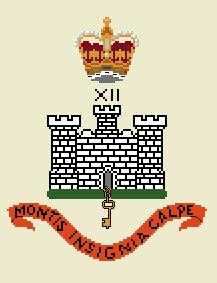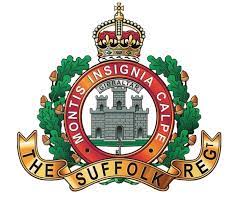The Suffolk Regiment was raised in 1685 by the Duke of Norfolk. It initially brought together men from Suffolk or Norfolk and also bore the name of the 12th Regiment of Foot (XIIth Foot).
In 1690, he participated in the Battle of the Boyne in Ireland against the forces of the Catholic King James II and was then sent to Flanders for a campaign against the armies of Louis XIV. In 1743, he played an important role in the Battle of Dettingen, a victory against the French army, then participated in the Battle of Fontenoy in 1745.
The Battle of Minden in 1759 was a new victory acquired in difficult conditions against the French. The anniversary of this battle is still celebrated every year in England.
From 1769, the regiment spent 14 years in Gibraltar and participated in the defense of the city besieged by the Spanish and the French. As a reward, the name “Gibraltar” and the arms of Gibraltar are granted to the Suffolk Regiment: a castle with a key and the motto “Montis Insignia Calpe”.
In 1783, the regiment took a new name: East Suffolk Regiment and mainly comprised men from this region. It carries out operations in the British Isles, Ireland, Flanders, Holland, Germany, Barbados and Martinique. In 1796, the regiment was sent for a first campaign in India and participated in the war against Sultan Tippoo by taking the fortified site of Seringapatam.

In 1810, a second battalion was set up and subsequently participated in the end of the French Campaign. At this time, the first battalion captured Mauritius and Bourbon Island (currently Reunion) then continued its journey to different points of the globe: Gibraltar, Ireland, Mauritius, England…
From 1851, the two battalions were sent to South Africa to fight against indigenous rebellions. The Birkenhead ship transporting troops and civilians sank near Cape Town in 1852. The perfect discipline of the soldiers of the Suffolk Regiment to let civilians take priority in the means of rescue is the historical origin of the famous expression used in the event of disaster: “Women and children first!”.
In 1854, the regiment received various assignments: Australia, New Zealand, England, Ireland, Scotland, Burma, Egypt, Aden, and from 1864 to 1892, maintained at least one battalion in India or Afghanistan.
Between 1899 and 1902, the regiment was engaged in the Boer War in South Africa.
First World War
Several battalions were launched into the war on different fronts in Europe: Le Cateau in 1914, Ypres, Neuve Chapelle in 1915, Somme in 1916, Arras in 1918, but also in the Middle East: Gaza and Gallipoli in 1915
Second World War
The first battalion was part of the British Expeditionary Force (BEF) in 1940: it fought in Belgium and France then was evacuated by Dunkirk. After four years of specific training, the first battalion was designated to be part of the assault troops of June 6, 1944 at Colleville-Montgomery and then participated in the Battle of Normandy. Suffolk was engaged in a very deadly battle at the Château de la Londe north of Caen on June 28, 1944. It then took part in operations in the sectors of Sannerville and Banneville, then Vire and Tinchebray and continued the advance of the allied armies in Holland (Overloon, Venraij) and in Germany near Bremen.
The second battalion participated in the Burma campaign, while the fourth and fifth battalions were attacked and taken prisoner by the Japanese in Singapore. Finally, the seventh battalion, converted into an armored regiment, participated in the Tunisian and Italian campaigns.
At the end of the conflict
Only the first battalion was kept in service, it continued to receive assignments around the world: Palestine, Greece, Malaysia, Trieste, Germany, Cyprus.
Only the first battalion was kept in service, it continued to receive assignments around the world: Palestine, Greece, Malaysia, Trieste, Germany, Cyprus.
Today it is part of the ‘Royal Anglian’.

